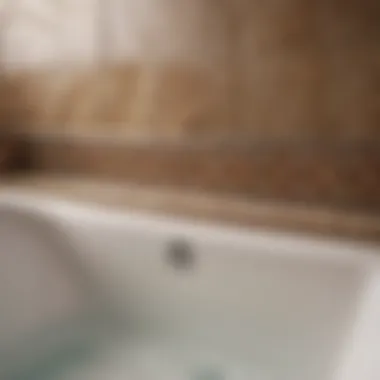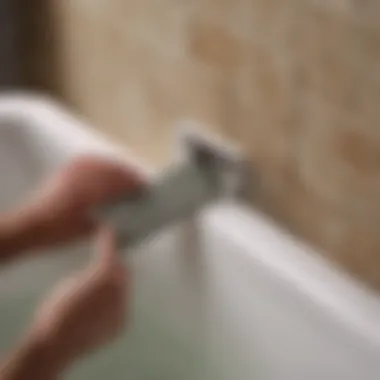Unveiling the Vital Role of Bathtub Tile Flange for Bathroom Protection


Materials:
- Bathtub tile flange (measuring 60 inches in length and 6 inches in width)
- Waterproof adhesive
- Caulk gun
- Utility knife
- Level
- Measuring tape
- Protective gloves
DIY Steps:
- Start by measuring the length and width of the bathtub to ensure the tile flange fits accurately.
- Apply a generous amount of waterproof adhesive along the edges of the bathtub where the tile flange will be installed.
- Carefully place the tile flange over the adhesive, ensuring it aligns perfectly with the edges of the bathtub.
- Use a level to check if the tile flange is straight and adjust if necessary.
- Once in place, press firmly to secure the flange onto the bathtub surface.
- Trim any excess flange material using a utility knife for a clean finish.
- Allow the adhesive to cure as per the manufacturer's instructions.
Technical Aspects:
The installation process should take approximately 1-2 hours. Make sure to wear protective gloves while handling adhesive and sharp tools. Ensure the area is well-ventilated for optimal adhesive performance.
DIY Project Process:
- Start by measuring and cutting the tile flange to fit the bathtub dimensions.
- Apply adhesive evenly and press the flange securely onto the surface.
- Check for alignment and trim any excess material for a neat appearance.
Troubleshooting Tips:
If the tile flange does not adhere properly, reapply adhesive and ensure it is pressed firmly. In case of any gaps, use caulk to seal the edges for added protection against water leakage.
Introduction
Bathtub tile flanges are a crucial component in bathroom fixtures, playing a significant role in maintaining a watertight seal and preventing water damage. Understanding the importance of bathtub tile flanges is essential for homeowners and professionals looking to enhance the longevity and functionality of their bathroom setups. In this comprehensive guide, we will delve into the intricacies of bathtub tile flanges, covering everything from their definition and purpose to the various types available in the market.
Overview of Bathtub Tile Flange
Definition and Purpose
The bathtub tile flange serves as a protective barrier that ensures a secure seal between the bathtub and the surrounding tiles. Its primary purpose is to prevent water from seeping into the walls and subfloor, thereby averting potential structural damage and mold formation. The key characteristic of bathtub tile flanges lies in their ability to create a seamless transition between the bathtub edge and the wall tiles, providing a clean and waterproof finish. Homeowners and professionals often opt for bathtub tile flanges due to their superior water-resistant properties and ease of installation, making them a popular choice for modern bathrooms.


Types of Bathtub Tile Flanges
Bathtub tile flanges come in various types to accommodate different installation requirements and design preferences. The most common types include molded flanges, adhesive flanges, and retrofit flanges. Molded flanges are pre-installed during the bathtub manufacturing process, offering a seamless integration with the tub. Adhesive flanges provide a flexible installation option, allowing for easy adjustment and alignment. Retrofit flanges are designed to be added onto existing bathtubs, making them ideal for renovation projects. Each type of bathtub tile flange has its unique features and advantages, offering homeowners and professionals a range of choices to suit their specific needs and preferences.
Importance of Watertight Seals
Prevention of Water Damage
One of the primary benefits of watertight seals, facilitated by bathtub tile flanges, is the prevention of water damage within bathroom structures. By creating a secure barrier against water infiltration, bathtub tile flanges mitigate the risk of leaks, moisture buildup, and decay. This proactive measure not only safeguards the integrity of the bathtub and surrounding fixtures but also preserves the structural stability of the entire bathroom space. The unique feature of preventing water damage through watertight seals is a critical aspect that contributes to the long-term maintenance and sustainability of bathroom installations.
Enhanced Durability of Bathroom Fixtures
Watertight seals play a pivotal role in enhancing the durability of bathroom fixtures, such as bathtubs, tiles, and grout. By minimizing water exposure and excess moisture, bathtub tile flanges contribute to the longevity of these components, reducing the likelihood of corrosion, mildew growth, and degradation. The key characteristic of watertight seals lies in their ability to fortify the structural integrity of bathroom fixtures, ensuring they withstand daily usage and environmental factors. The added advantage of improved durability not only extends the lifespan of bathroom fixtures but also reduces the need for frequent repairs and replacements, ultimately saving homeowners time and money.
Installation Process
The Installation Process plays a pivotal role in ensuring the effectiveness and longevity of bathtub tile flanges. Proper installation techniques are crucial for creating a watertight seal and preventing water damage in bathrooms. Homeowners and professionals must pay attention to specific elements within the Installation Process to guarantee optimal results.
Preparation Steps
Cleaning and Drying the Area
Cleaning and drying the area where the bathtub tile flange will be installed is a critical step in the Installation Process. By ensuring that the surface is free from dirt, dust, and moisture, you create a suitable environment for the flange to adhere properly. This meticulous cleaning process promotes better adhesion of the adhesive sealant, which is essential for sealing the flange securely to prevent any water leakage.
Applying Adhesive Sealant
Applying adhesive sealant is a fundamental aspect of installing a bathtub tile flange. The adhesive sealant acts as a barrier against water penetration, maintaining the integrity of the seal over time. Its ability to adhere to various materials and surfaces makes it a popular choice for achieving a durable and waterproof seal. However, it is crucial to follow manufacturer instructions to ensure proper application to maximize the effectiveness of the sealant in this article.
Securing the Flange
Aligning with Bathtub Rim


Aligning the bathtub tile flange with the bathtub rim is integral to create a seamless and secure seal. By aligning the flange correctly, you prevent gaps or uneven surfaces that could compromise the watertight seal. The key characteristic of this step is precision and attention to detail to ensure a perfect fit that enhances the overall functionality of the flange. While this process may seem simple, its importance cannot be overstated in achieving a leak-proof installation in this article.
Firmly Pressing into Place
Firmly pressing the bathtub tile flange into place is essential for establishing a sturdy bond between the flange and the bathtub rim. By exerting pressure evenly across the surface, you guarantee maximum contact between the flange and the underlying structure, promoting long-term durability. This technique ensures that the flange remains securely in position, reducing the risk of water seepage or displacement. While it may require some physical effort, the benefits of firmly pressing the flange into place far outweigh any initial challenges in this article.
Sealing Techniques
Silicone Caulk Application
The silicone caulk application is a vital sealing technique that provides an additional layer of protection to the bathtub tile flange. Silicone caulk's flexibility and waterproof properties make it an ideal choice for sealing joints and edges, securing the flange against water intrusion effectively. Its unique feature lies in its ability to withstand moisture and temperature fluctuations without deteriorating, ensuring a durable seal that lasts over time. Homeowners and professionals can rely on silicone caulk to bolster the watertight integrity of the bathtub tile flange, safeguarding against leaks and damages in this article.
Ensuring Uniform Seal
Ensuring a uniform seal around the bathtub tile flange is essential for guaranteeing comprehensive protection against water leaks. By carefully applying and smoothing out the sealant along the edges and seams, you eliminate potential weak points that could compromise the waterproof barrier. The key characteristic of this technique is consistency, as any gaps or inconsistencies may undermine the seal's effectiveness. Achieving a uniform seal not only enhances the aesthetic appeal of the installation but also reinforces its structural integrity, showcasing attention to detail and quality workmanship in this article.
Maintenance and Care:
Maintenance and care are crucial aspects of ensuring the longevity and functionality of bathtub tile flanges, contributing significantly to the overall well-being of your bathroom fixtures. By following proper maintenance practices and regular care routines, homeowners can prevent potential issues and extend the lifespan of their flanges.
Taking care of your bathtub tile flanges involves various steps to maintain their optimal condition. Regular inspection for mold growth is essential in identifying early signs of moisture accumulation that could lead to mold or mildew formation. By inspecting the flange periodically, homeowners can address any mold-related concerns promptly, ensuring a hygienic environment in the bathroom.
In addition to mold inspection, using mild cleaning agents is highly recommended to maintain the cleanliness and aesthetics of the flanges. Mild cleaning agents are gentle on the surfaces, removing dirt, grime, and soap scum without causing damage to the flange material. This gentle approach helps preserve the integrity of the flanges over time, keeping them looking brand new.
Cleaning Guidelines:
Regular Inspection for Mold Growth:
Regular inspection for mold growth plays a crucial role in maintaining the hygiene and structural integrity of bathtub tile flanges. By routinely checking for any signs of mold or mildew, homeowners can address moisture issues promptly, preventing the spread of harmful microorganisms in the bathroom. The key characteristic of regular mold inspection is its preventive nature, allowing early intervention to avoid extensive mold infestations that could compromise the flange's functionality. This proactive approach helps homeowners uphold a clean and healthy environment while prolonging the lifespan of their fixtures.


Using Mild Cleaning Agents:
Utilizing mild cleaning agents is an effective method for keeping bathtub tile flanges in pristine condition. The key characteristic of mild cleaning agents is their gentle yet powerful cleaning properties, capable of removing dirt and grime without causing damage to the flange surfaces. This choice is popular in maintenance routines for its ability to provide effective cleaning results without harsh chemicals that could potentially harm the flanges. The unique feature of mild cleaning agents lies in their ability to maintain the cleanliness of the flanges while preserving their finish, ensuring long-term durability and aesthetic appeal.
Preventive Measures:
Avoiding Harsh Chemicals:
Implementing preventive measures such as avoiding harsh chemicals is paramount in preserving the integrity of bathtub tile flanges. By steering clear of abrasive substances, homeowners can prevent unwanted corrosion or discoloration of the flanges, maintaining their original appearance. The key characteristic of avoiding harsh chemicals is its protective nature, safeguarding the flanges against chemical-related damage that could compromise their structural integrity. This beneficial choice aligns with the maintenance goals of the article, promoting a safe and sustainable approach to caring for bathroom fixtures.
Prompt Repairs of Damaged Flanges:
Addressing damaged flanges promptly is essential in preventing further deterioration and potential leaks in the bathroom. The key characteristic of prompt repairs is their proactive nature, allowing homeowners to resolve issues quickly and effectively to maintain the functionality of the fixtures. By addressing damaged flanges in a timely manner, homeowners can prevent costly repairs and potential water damage, ensuring the long-term sustainability of their bathroom.
Common Issues and Troubleshooting
In the realm of bathroom maintenance and renovation, understanding common issues and troubleshooting techniques related to bathtub tile flanges is paramount. By delving into possible challenges and their solutions, homeowners and professionals can proactively address issues, ensuring the longevity and performance of their bathroom fixtures.
Leakage Problems
Identifying Potential Leak Points
When it comes to leakage problems in the context of bathtub tile flanges, identifying potential leak points is a critical aspect. By focusing on pinpointing areas where leaks are likely to occur, individuals can take proactive measures to prevent water damage and uphold the integrity of their bathroom structure. The key characteristic of identifying potential leak points lies in meticulous inspection and attention to detail. This approach allows for the early detection of vulnerable areas, enabling prompt action to mitigate potential leakage risks. The advantage of this method lies in its preventive nature, which can save homeowners from costly repairs and extensive water damage. By recognizing and addressing potential leak points early on, individuals can safeguard their bathroom fixtures and enjoy peace of mind.
Addressing Sealant Failures
Another crucial aspect of leakage problems in bathtub tile flanges is addressing sealant failures effectively. Sealant failures can lead to water seepage and compromise the watertight seal of the flange, posing a risk of water damage to the surrounding areas. By focusing on addressing sealant failures promptly, individuals can prevent further escalation of leakage issues. The key characteristic of tackling sealant failures is swift intervention and the use of high-quality sealants. This approach ensures that any compromised sealant is swiftly replaced or reinforced, restoring the flange's effectiveness in preventing leaks. While addressing sealant failures may require time and effort, the benefits far outweigh the challenges. By maintaining a proactive stance towards sealant maintenance, individuals can uphold the functionality and durability of their bathtub tile flanges, ensuring a watertight environment in their bathrooms.
Structural Integrity Concerns
Supporting Weak Flanges
Considering structural integrity concerns related to bathtub tile flanges, supporting weak flanges emerges as a vital consideration. Weak flanges are susceptible to damage and may compromise the overall stability of the bathtub installation. By focusing on fortifying weak flanges, individuals can enhance the structural robustness of their bathroom fixtures, promoting longevity and safety. The key characteristic of supporting weak flanges lies in selecting appropriate support mechanisms that align with the bathtub's design and weight distribution. This ensures that the flanges are adequately reinforced, minimizing the risk of structural failures. The advantage of supporting weak flanges lies in the preservation of the bathtub's integrity and the prevention of potential hazards. Through strategic reinforcement, individuals can enjoy a stable and secure bathing environment, free from concerns about structural weaknesses.
Reinforcement Techniques
To address structural integrity concerns effectively, the implementation of reinforcement techniques plays a pivotal role in ensuring the durability of bathtub tile flanges. Reinforcement techniques encompass a range of approaches focused on strengthening the flanges and supporting the surrounding structure. The key characteristic of reinforcement techniques is their versatility, allowing individuals to tailor the reinforcement strategy to suit the specific needs of their bathroom fixtures. This flexibility enables targeted reinforcement where it is most needed, enhancing the overall stability and performance of the bathtub installation. The advantage of utilizing reinforcement techniques lies in the proactive approach to preventing structural issues and extending the lifespan of the bathroom fixtures. By incorporating reinforcement techniques into regular maintenance routines, individuals can fortify their bathtub tile flanges against wear and tear, preserving the aesthetic and functional appeal of their bathroom space.







